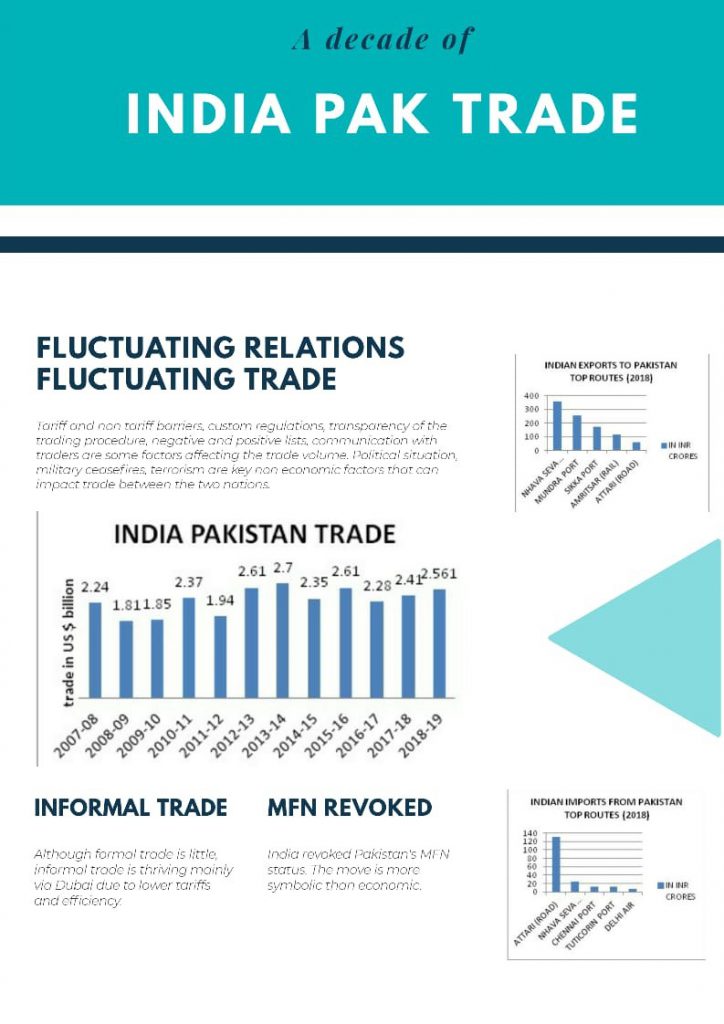
A DECADE OF FLUCTUATING TRADE – THE STORY OF INDIA PAKISTAN
Henry George once said that trade has been the extinguisher of war, the eradicator of prejudice and the diffuser of knowledge. India and Pakistan are yet to reap these benefits of trade and end the era of political tensions that have been shadowing the economic activities of these nations.
Even though the trade potential between the neighboring nations is estimated at USD 37 billion by the World Bank, bilateral trade remains meager at around USD 2 billion per year. The advantage of geographical proximity and a long border remains unused as political and military tensions along with an inefficient trading procedure, have kept bilateral trade between the nations at a bare minimum.
Some developments in the last decade have been:
In 2008, Pakistan increased the size of its positive list[1]. In 2011, the nations signed three agreements: Customs Cooperation Agreement[2], Mutual Recognition Agreement[3] and Redressal of Trade Grievances Agreement[4] to encourage trade. In 2011, Pakistan agreed to confer the MFN status to India but the decision was never made official. In 2012, for the first time, the ministers of Commerce of both the nations visited the other country. An Integrated Check Post was also inaugurated at Attari in a major boost to trade infrastructure between the nations. In 2019, after a terrorist attack in Pulwama, India revoked Pakistan’s MFN status.
Trade between India and Pakistan has been fluctuating due to a variety of factors. Policy related factors like tariff and non tariff barriers, negative and positive lists, Most Favored Nation (MFN) status impact the volume of trade. Custom procedures, regulatory requirements, communication with traders across the border, transparency of the trading system are also making the trade volume fluctuate. Non economic factors perhaps play the biggest role in affecting trade volume. Political decisions, terrorist activities, military ceasefires are measures that impact trade.

The top exports from India to Pakistan (2018-19) were: cotton, organic chemicals, plastic and plastic articles, tanning or dyeing extracts; tannins and their deri; dyes, pigments and other coloring matter; paints and ver; putty and other mastics; inks, nuclear reactors, boilers, machinery and mechanical appliances; parts thereof.[5]
The top imports to India from Pakistan (2018-19) were: edible fruit and nuts; peel or citrus fruit or melons, mineral fuels, mineral oils and products of their distillation; bituminous substances; mineral waxes. salt; sulphur; earths and stone; plastering materials, lime and cement, ores, slag and ash raw hides and skins (other than fur skins) and leather [6]
The various modes of transport used for trade are land via the Attari-Wagah border, sea via Mundra, Nhava Seva, Sikka, Chennai, Tuticorin, rail via Amritsar and air via Delhi, Kolkata.


Source: Ministry of Commerce and Industry, Government of India
Another interesting fact is that while formal trade between the nations is little, informal trade[7] has been flourishing. In the year 2012-13, informal trade between the countries was estimated to be USD 4.71 billion (Taneja and Bimal, 2016) which was twice the value of formal trade that year.
As per an ICRIER Survey September 2013- March 2014, the main reasons for the large volume of informal trade is the negative list, ease of trading via a third country and political tensions between the nations. Dubai acts as a major hub for India Pakistan trade as Dubai has duty free zones and a business friendly environment for trade. The top commodities traded via the informal route are jewelry, textiles and machinery. (ICRIER Survey September 2013- March 2014) Majority of the commodities exported informally are ones present on Pakistan’s negative list or sensitive list or both. Other than that, low tariffs and efficiency make informal trade look attractive vis-à-vis formal trade even as transportation costs along the informal route are higher.
In a significant blow to trading relations, Pakistan’s MFN[8] status was revoked by India after a terrorist attack in Pulwama this year. It basically means India will now charge higher tariffs from Pakistan and this step was indeed followed by a 200% hike on all Pakistani imports. This move however, is deemed to be more symbolic than economic as the imports from Pakistan to India are abysmally low and slapping a custom duty on them will hurt Pakistan very little and only till it doesn’t find alternate markets. It may actually hurt India as the major trade between the nations consists of Indian exports and Pakistan is bound to increase its tariffs in response to the Indian side doing so.
The neighbors have enormous trade potential and must continue to have dialogue, trade and travel to ease the differences between them, interlink their economies and have a healthy exchange of cultures.
Muskan Saluja is Economics Undergraduate Student at Sri Venkateswara College, DU and interned at BRIEF in June-July 2019. Views expressed are personal.
[1] Only goods present in this list were allowed to be imported from India to Pakistan.
[2] This agreement signed between the two nations agreed to develop mutual understanding on matters relating to Customs. The Customs Administrations agreed to cooperate in research, development and application of Customs processes.
[3] Signed between Bureau of Indian Standards (BIS) and Pakistan Standard and Quality Control Authority (PSQCA) and between Export Inspection Council of India (EIC) and PSQCA.
[4] Aims at streamlining trade and removing hindrances.
[5] Ministry of Commerce and Industry, Government of India (https://commerce-app.gov.in/eidb/default.asp)
[6] Ministry of Commerce and Industry, Government of India (https://commerce-app.gov.in/eidb/default.asp)
[7] Indirect/informal trade takes place between the two nations either through a third country or illegal trade via land borders
[8] Most favored nations (MFN) is a status or level of treatment accorded by one state to another in international trade. The term means the country which is the recipient of this treatment must nominally receive equal trade advantages as the “most favored nation” by the country granting such treatment. (Trade advantages include low tariffs or high import quotas)
